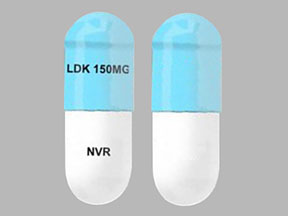Zykadia Dosage
Generic name: CERITINIB 150mg
Dosage form: capsule
Drug class: Multikinase inhibitors
Medically reviewed by Drugs.com. Last updated on Jan 11, 2024.
2.1 Patient Selection
Select patients for treatment of metastatic NSCLC with ZYKADIA based on the presence of ALK positivity in tumor specimens [see Clinical Studies (14.1)].
Information on FDA-approved tests for the detection of ALK rearrangements in NSCLC is available at: http://www.fda.gov/CompanionDiagnostics.
2.2 Recommended Dosage
The recommended dosage of ZYKADIA is 450 mg orally once daily with food until disease progression or unacceptable toxicity [see Clinical Pharmacology (12.3)].
If a dose of ZYKADIA is missed, make up that dose unless the next dose is due within 12 hours.
If vomiting occurs during the course of treatment, do not administer an additional dose and continue with the next scheduled dose of ZYKADIA.
2.3 Dosage Modifications for Adverse Reactions
| Dose Reduction | Recommended Dosage |
| First-dose reduction | 300 mg taken orally once daily with food |
| Second-dose reduction | 150 mg taken orally once daily with food |
Discontinue ZYKADIA for patients unable to tolerate 150 mg taken orally once daily with food.
Dosage modifications for selected adverse reactions of ZYKADIA are provided in Table 2. If dose reduction is required due to an adverse reaction not listed in Table 2, then reduce the daily dose of ZYKADIA by 150 mg.
| Adverse Reaction | ZYKADIA Dose Modification |
| Gastrointestinal Adverse Reactions [see Warnings and Precautions (5.1)] | |
| Severe or intolerable nausea, vomiting, or diarrhea despite optimal antiemetic or anti-diarrheal therapy | Withhold until improved, then resume ZYKADIA at the next lower dosage. |
| Hepatotoxicity [see Warnings and Precautions (5.2)] | |
| ALT or AST elevation greater than 5 times ULN with total bilirubin elevation less than or equal to 2 times ULN | Withhold until recovery to baseline or less than or equal to 3 times ULN, then resume ZYKADIA at the next lower dosage. |
| ALT or AST elevation greater than 3 times ULN with total bilirubin elevation greater than 2 times ULN in the absence of cholestasis or hemolysis | Permanently discontinue ZYKADIA. |
| Interstitial Lung Disease/Pneumonitis [see Warnings and Precautions (5.3)] | |
| Any Grade treatment-related ILD/pneumonitis | Permanently discontinue ZYKADIA. |
| QT Interval Prolongation [see Warnings and Precautions (5.4)] | |
| QTc interval greater than 500 msec on at least 2 separate ECGs | Withhold until QTc interval is less than 481 msec or recovery to baseline if baseline QTc is greater than or equal to 481 msec, then resume ZYKADIA at the next lower dosage. |
| QTc interval prolongation in combination with torsades de pointes or polymorphic ventricular tachycardia or signs/symptoms of serious arrhythmia | Permanently discontinue ZYKADIA. |
| Hyperglycemia [see Warnings and Precautions (5.5)] | |
| Persistent hyperglycemia greater than 250 mg/dL despite optimal anti-hyperglycemic therapy | Withhold until hyperglycemia is adequately controlled, then resume ZYKADIA at the next lower dosage. If adequate hyperglycemic control cannot be achieved with optimal medical management, discontinue ZYKADIA. |
| Bradycardia [see Warnings and Precautions (5.6)] | |
| Symptomatic bradycardia that is not life-threatening | Withhold until recovery to asymptomatic bradycardia or to a heart rate of 60 bpm or above, evaluate concomitant medications known to cause bradycardia. If bradycardia cannot be attributed to another drug, resume ZYKADIA at the next lower dosage. |
| Clinically significant bradycardia requiring intervention or life-threatening bradycardia in patients taking a concomitant medication also known to cause bradycardia or a medication known to cause hypotension | Withhold until recovery to asymptomatic bradycardia or to a heart rate of 60 bpm or above. If the concomitant medication can be adjusted or discontinued, resume ZYKADIA at the next lower dosage with frequent monitoring. |
| Life-threatening bradycardia in patients who are not taking a concomitant medication also known to cause bradycardia or known to cause hypotension | Permanently discontinue ZYKADIA. |
| Pancreatitis [see Warnings and Precautions (5.7)] | |
| Lipase or amylase elevation greater than 2 times ULN | Withhold until recovery to less than 1.5 times ULN, then resume ZYKADIA at the next lower dosage. |
| Abbreviations: AST, aspartate aminotransferase; ALT, alanine aminotransferase; ULN, upper limit of normal; ILD, interstitial lung disease; ECG, electrocardiogram; bpm, beats per minute. | |
2.4 Dosage Modification for Strong CYP3A Inhibitors
Avoid concurrent use of strong CYP3A inhibitors during treatment with ZYKADIA [see Drug Interactions (7.1), Clinical Pharmacology (12.3)].
If concurrent use of a strong CYP3A inhibitor is unavoidable, reduce the ZYKADIA dose by approximately one-third, rounded to the nearest multiple of the 150 mg dosage strength. After discontinuation of a strong CYP3A inhibitor, resume the ZYKADIA dose that was taken prior to initiating the strong CYP3A inhibitor.
2.5 Dosage Modification for Patients With Severe Hepatic Impairment
For patients with severe hepatic impairment (Child-Pugh C), reduce the ZYKADIA dose by approximately one-third, rounded to the nearest multiple of the 150 mg dosage strength [see Use in Specific Populations (8.6), Clinical Pharmacology (12.3)].
Frequently asked questions
More about Zykadia (ceritinib)
- Check interactions
- Compare alternatives
- Pricing & coupons
- Drug images
- Side effects
- During pregnancy
- FDA approval history
- Drug class: multikinase inhibitors
- Breastfeeding
- En español
Patient resources
Professional resources
Related treatment guides
Further information
Always consult your healthcare provider to ensure the information displayed on this page applies to your personal circumstances.


